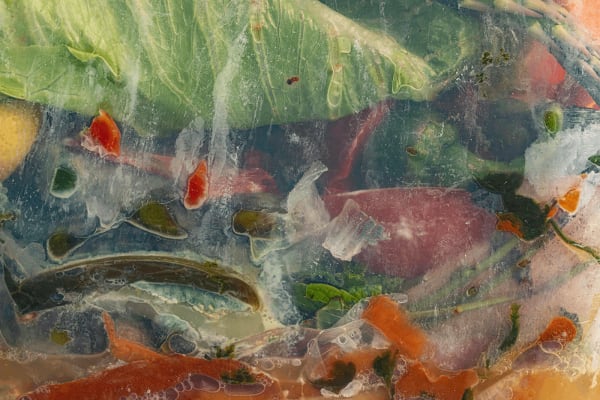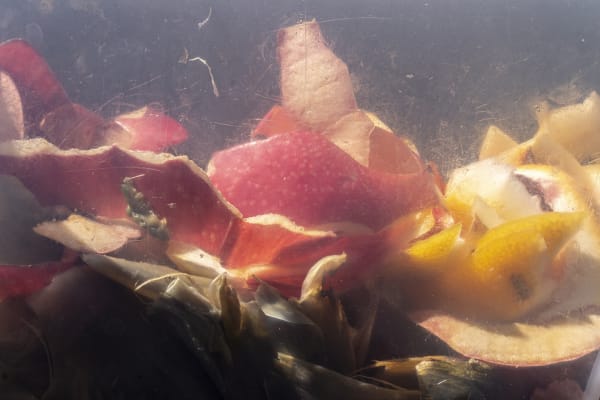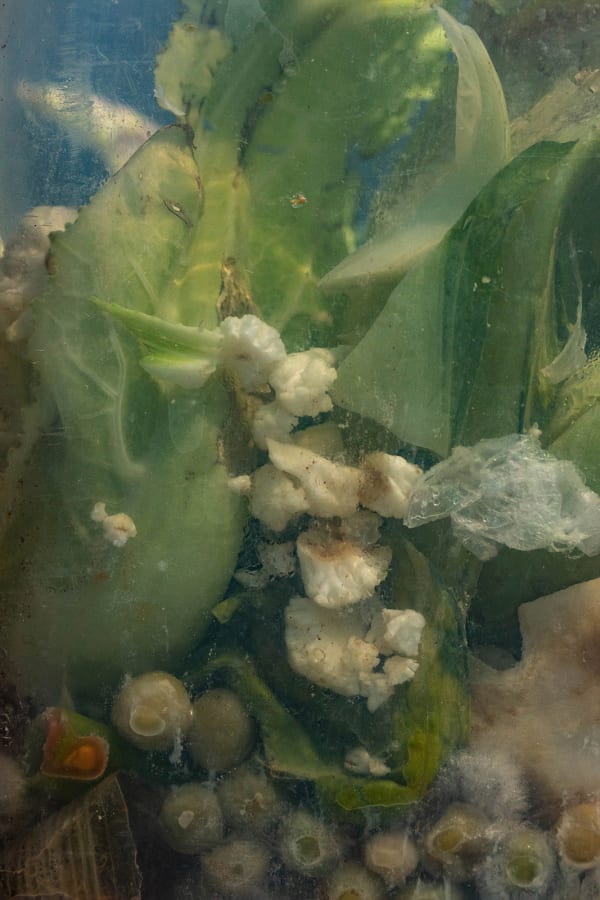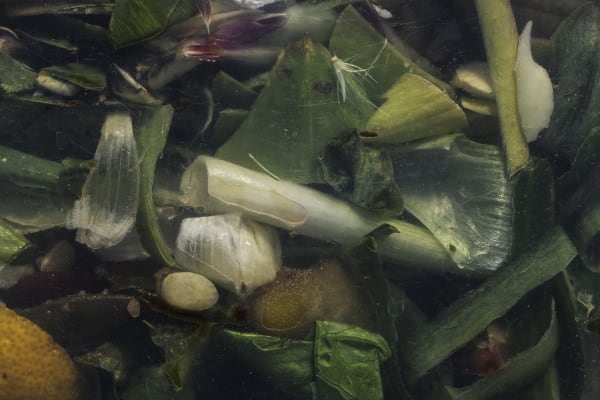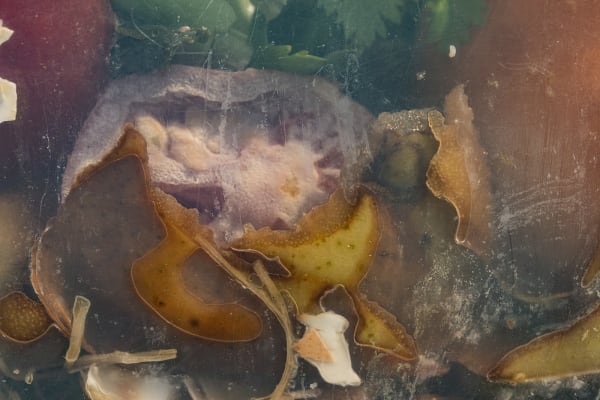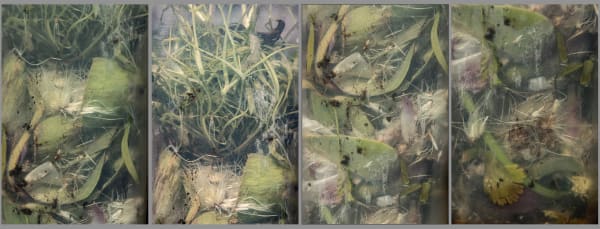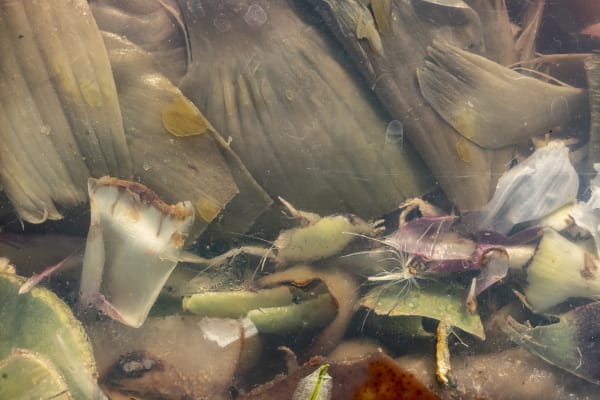-
From Memento Mori to Visual Alchemy: Nancy Macko's Decompositions
-

-
-
SIZES IN EXHIBITION HAVE BEEN ADJUSTED FOR THE PURPOSE OF PRESENTATION. ALL WORKS WITH TRUE SIZES ARE LISTED IN THE ARTWORK GRIDS BELOW. The Biography and Essay follow.
-
-
-

Nancy Macko
After Pollock, 2020
Archival pigment print
26 X 40 or 15 X 22.5 inches
-

Nancy Macko
Anemone Garden, 2022
Archival pigment print
26 x 40 or 15 x 22.5 inches
-

Nancy Macko
Applescape 1, 2022
Archival pigment print
42 X 64.5 or 26 X 40 inches
-

NANCY MACKO
Asparagus Kindling, 2020
Archival pigment print
26 x 40 or 15 x 22.5 inches
-

Nancy Macko
Bee Breast Choke, 2022
Archival pigment print
36 X 36 or 24 X 24 inches
-

Nancy Macko
Bite, 2020
Archival pigment print
26 x 40 or 15 x 22.5 inches
-

Nancy Macko
Cauli Olive, 2020
Archival pigment print
40 x 26 or 22.5 x 15 inches
-

Nancy Macko
Choke Stool Faerie, 2021
Archival pigment print
42 x 64.6 or 26 x 40 inches
-

Nancy Macko
Color Wheel, 2021
Archival pigment print
64.5 x 42 or 32 x 21 inches
-

Nancy Macko
Compression, 2020
Archival pigment print
40 x 26 or 22.5 x 15 inches
-

Nancy Macko
Cornucopia, 2022
Archival pigment print
40 x 26 or 22.5 x 15 inches
-

Nancy Macko
Dickinson, 2020
Archival pigment print
40 x 26 or 22.5 x 15 inches
-
-
-
-

Nancy Macko
Garlic Cotton, 2020
Archival pigment print
40 x 24 or 22.5 x 13 inches
-

Nancy Macko
Garlic Sheaves, 2020
Archival pigment print
26 x 40 or 15 x 22.5 inches
-

Nancy Macko
Garlic Wings Nebula, 2020
Archival pigment print
64.5 x 42 or 32 x 21 inches
-

Nancy Macko
Green Tumble, 2022
Archival pigment print
26 x 40 or 15 x 22.5 inches
-

Nancy Macko
Green Web, 2020
Archival pigment print
40 x 26 or 22.5 x 15 inches
-

Nancy Macko
Lemonthyme Jungle, 2021
Archival pigment print
26 x 40 or 15 x 22.5 inches
-

Nancy Macko
Lochness, 2020
Archival pigment print
40 x 26 or 22.5 x 15 inches
-

Nancy Macko
Miss Havisham's Desk, 2020
Archival pigment print
40 x 26 or 22.5 x 15 inches
-
-
-
-

Nancy Macko
Passage, 2020
Archival pigment print
40 x 80 or 20 x 40 inches
-

Nancy Macko
Push Pull, 2022
Archival pigment print
26 x 40 or 15 x 22.5 inches
-

Nancy Macko
Snowman, 2020
Archival pigment print
40 x 26 or 22.5 x 15 inches
-

Nancy Macko
Squish, 2020
Archival pigment print
40 x 26 or 22.5 x 15 inches
-

Nancy Macko
Still Live (After Caravaggio), 2022
Archival pigment print
40 x 26 or 22.5 x 15 inches
-

Nancy Macko
Still Life with Fairy Lights and Dying Thyme, 2021
Archival pigment print
40 x 26 or 22.5 x 15 inches
-

Nancy Macko
Tangled Microcosm, 2022
Archival pigment print
42 x 120 or 31 x 60 inches
-

Nancy Macko
The Light In the Creek, 2020
Archival pigment print
26 x 40 or 15 x 22.5 inches
-
-
-
-

Nancy Macko
Vigil, 2022
Archival pigment print
40 x 26 or 22.5 x 15 inches
-

Nancy Macko
Waterfall, 2020
Archival pigment print
42 x 90 or 22.5 x 45 inches
-

Nancy Macko
Waterfall (Mural), 2020
Digital output on vinyl
89 x 144 inches
-

Nancy Macko
Weather Patterns, 2020
Archival pigment print
42 x 64.5 or 21 x 32 inches
-
-
-
 Nancy Macko
Nancy Macko -
-
-
By Mary Davis MacNaughton
The cycle of life is a continuous theme in Nancy Macko’s art, and it reappears in new form in her 2020 series Decompositions. In these works, fluid space and diaphanous color seduce, then startle viewers, as they slowly realize that the forms depicted are decomposing vegetables. In these photographs, simple food scraps morph into mysterious entities with changing identities.
During 2020, the Covid year of social isolation, Macko began this photographic series when, as she explains, “my home was my solace” and the “kitchen compost became a great source of inspiration for me, as it represented not only what scraps we could recycle, but also the love and care that went into the preparation of our food.” (1)
Macko’s interest in and respect for nature took root in her twenties when she lived for a year on a 400-acre farm in Wisconsin. In this rural location, she saw how food was produced and learned the growth cycle for alfalfa, corn, and soybeans. Macko also came to understand that different kinds of life are interconnected. Since the early 1990s, she has concentrated much of her art on honeybees and their importance in facilitating the life cycle of plants.
Decompositions extend Macko’s earlier photographic series that examine the intersection of bees and plants. To bring attention to the vital role of bees in food production, Macko has focused her work on the life cycle of flowers and vegetables, which she saw close at hand in her own garden for more than a decade. Beginning in 2014, she initiated a methodical, in-depth study of bee-attracting flowers. In this work, which explored the honeybee and its crucial role in pollinating and facilitating the life cycle, she had three goals: to document plants from bud to full bloom to withered petals; to see flowers at close range; and to present their various life phases in a large format. Instead of the distance afforded by the tripod, she opted for intimacy of the hand-held camera. From her garden roses she moved to native plants that she sourced from California Botanical Garden, near her home, in Claremont, CA. In 2015, she presented this body of work in the exhibition The Fragile Bee, which included Botanical Portraits:SoCal. (2)
Macko thinks of her work in relation to philosopher Michel Foucault’s concept of heterotopia, a term he used to describe spaces that can be both disturbing and/or transforming. (3) One could say that Macko’s works create heterotopias of place and time, in that the locations they depict unsettle our expectations because these spaces are both actual and virtual. For example, in the series Botanical Portraits, the garden is at once real and invented; she documents flowers and bees in specific moments, then she arranges these disparate instants into imaginative images of timeless life cycles. Macko’s garden images, like Foucault’s heterotopias, are microcosms, at once of the world and outside it.
An overarching concern for Macko has been the ongoing decline of honeybees, seen in the colony collapse disorder (4), which has been attributed in large part to damage by pesticides and fungicides that have dramatically reduced the number of bees. Macko believes that “The plight of the bees will cause catastrophic starvation if we do not change the way our foods are grown and fertilized.” (5)
In Decompositions, Macko shifts from garden bees to kitchen compost, and from looking at the whole cycle of a plant’s life--including bud, bloom, and seed--to concentrating on the end of life, evident in food scraps. In works like Green Web, however, where discarded rinds hold seeds, Macko shows both signs of decay and hints of regeneration. To convey life in flux, Macko creates images that have multiple associations, often calling up the landscape or the body. In Garlic Sheaves, paper-thin skins give rise to twisted tree trunks slowly disintegrating on the forest floor; in Compression, compacted carrots, celery, and onions elicit settling geologic strata. In Wound, a seed pod evokes a fetus forming in a womb.
Mackos’ vision resonates with works of other artists who have dwelled on transformation. In Odalisque, cabbage leaves fold like fleshy pillows, and silken, swooning contours recall the languid French odalisques of Jean Dominique Ingres. There is also a hint of surrealist metamorphic imagery in which food stuff transmutes into other life forms. For example, in Macko’s Lochness, a celery stalk becomes a strange hybrid creature, at once vegetal and animal.
Like surrealists Leonora Carrington (1917-2011) and Remedios Varo (1908-1963), Macko creates an imaginary visual universe. Carrington and Varo developed their mature works after separating from surrealism in Paris and settling, during World War II, in Mexico, where they created marvelous worlds influenced by their interest in the occult and mysticism. Carrington and Varo also shared an interest in ancient matriarchal societies, a subject that Macko explored in earlier paintings, prints, and digital media that were featured in her large mid-career exhibition Hive Universe. (6) Yet the works of these artists diverge: In paintings, Carrington and Varo invented magical other worlds of bizarre personages. By contrast, in her digital photographs Macko finds magic in this world--in her garden and compost.
Magnification is Macko’s method of converting the simple into the extraordinary, and transforming the familiar into the unfamiliar, a strategy also employed by surrealists. For instance, in a 1936 photograph Ubu, surrealist Dora Maar (1907-1997) depicted a small unidentified animal fetus, possibly an armadillo, so greatly enlarged that she made the miniature monstrous. Photographing with a Macro lens, Macko dramatically ramps up scale of her subjects. She began using this method in the earlier series Intimate Spaces 1 and 2 (2008-2013), and still finds it compelling today.
By shifting scale, Macko alters our understanding of what we see: in Decompositions, she converts the small into the large and makes the forgotten memorable. For example, in Cauli Olive, she gives tiny, cauliflower florets couched in dark green stalks the dynamic energy of a Baroque sculpture. In Weather Patterns, she summons gaseous clouds from disintegrating lettuce leaves that echo a satellite view of the earth’s atmosphere. And, in The Light in the Creek, she transmutes a fennel frond into a giant tree. By printing these works on large formats, Macko also enhances the expressive effect of their transformed identities.
In visualizing material transformation, Macko’s art also resonates with alchemy, the medieval precursor to chemistry and speculative philosophy that inspired many artists, including
surrealists Leonora Carrington and Remedios Varo. Though Macko is not a follower of alchemy, her images seem alchemical in the way they dwell on the notion of matter moving from one state into another. Nevertheless, there are distinctions to be made. While medieval practitioners sought to convert base metals into actual gold, Macko finds metaphoric gold in the process of biological metamorphosis. While alchemists worked their magic in a still-like container called an alembic; Macko simply uses a transparent compost container. While alchemists searched for the “universal solvent” that could dissolve any substance, Macko finds universality in the process of decomposition and regeneration fundamental to life.
The central motif of decay in Macko’s photographs aligns with the artistic trope of memento mori, roughly translated, “Remember that you die.” The admonition has ancient roots, supposedly spoken during a triumphal procession by a slave to a general, as a reminder of mortality. (7) Roman Emperor and Stoic philosopher Marcus Aurelius, in his Meditations, prompted readers to “consider how ephemeral and mean all mortal things are." (8) During the medieval and Renaissance eras, the notion of memento mori often appeared in architectural and artistic motifs. By the 16th and 17th centuries in Europe, the memento mori theme became embedded in the painted vanitas still life (9), in which symbols of death ranged from the direct--as in bones and skulls--to the allusive--as in burning candles, fading flowers, and dwindling hourglasses. These symbols carried the foreboding message that time is running out and viewers should turn their thoughts from this life to the next.
Traditionally considered a minor genre in comparison to religious subjects, still life painting was elevated by Baroque artist Michelangelo Merisi da Caravaggio (1571-1610), who gave the subject gravitas by powerfully fusing realism and symbolism. (10) In Still Life with Fruit on a Stone Ledge, 1601-1601, Caravaggio both meticulously rendered a panoply of ripe fruit and referred to life and death. Through figs, gourds, grapes, and melons conveying abundance and fertility he also introduced darker notes. Grapes conjure excess and intoxication in their allusion to Dionysus, the god of wine; and summon death and resurrection, as in the Last Supper, when Jesus referred to wine as his blood. Similarly, red pomegranates elicit beauty and fertility as well as blood and death. Caravaggio understood that still life could encompass both documentary description and subtle allusion; and Macko nods to his example in her Still Life (After Caravaggio).
Macko belongs to a tradition of women artists who found still life to be a rich subject. In the Renaissance and Baroque eras, still life painting was dominated by male artists, but certain women painters of the late 16th and 17th centuries made significant contributions to the genre. Their artistic accomplishments are made clear in the 2022 exhibition at Colnaghi London, Forbidden Fruit: Female Still Life. This exhibition featured paintings by many esteemed women, including Giovanna Garzoni (1600-1670), who was one of the earliest female painters devoted to still life; Caterina Angeli Pierozzi (1670-1690), whose patroness was Grand Duchess Vittoria della Rovere; and Rachael Ruysch (1664-1750), Dutch botanical artist whose paintings attracted international collectors. (11) Ruysch, who was acclaimed during her lifetime, is one of the most documented painters in early 18th- century Netherlands. Ruysch was best known for her lifelike paintings of abundant flower bouquets that seem natural rather than composed. Her keen observations were inspired by her visits to botanical gardens and work with her physician and botanist father, who collected specimens of plants and insects that he carefully embalmed so that they looked alive. Similarly, in her painting Fruit and Insects, 1711 (Galleria degli Uffizi, Florence), Ruysch gives a peach and fly an uncanny lifelike quality. In this work, Ruysch evokes harvest in a glistening array of grapes, peaches, and nectarines, while adding a fly and butterfly that suggest decay and death as well as change and transformation.
Both Ruysch and Macko reward the viewer who looks slowly and closely, and who discovers in the process surprising details. Whereas in Fruit and Insects, Ruysch lands a fly on a peach, in Vigil Macko tucks a bee next to a lemon peel. In Divine Intervention and Cornucopia, Macko captures a few tiny ants that for the viewer, at first glance, appear like grains of pepper. Whereas Ruysch is fascinated by the seldom seen underside of leaves, Macko in Green Tumble looks carefully at the discarded ends of vegetables, magnifying green onions or asparagus stalks into floating logs. In Bee Breast Choke and Tide Pool with Sea Lions, Macko brings forth spidery creatures out of vegetal strings and watery whisps. In Applescape 1, Macko enlarges, stacks, and illuminates edges of apple skins to conjure mountain peaks at dusk.
Macko’s images do not present decay in an anxious, disquieting light, but rather in a calm, meditative one, suggesting that death is merely a stage in the cycle of life. Instead of conveying fear of the unknown, Macko accepts what is inevitable in closeup views of what is familiar: composting. An oxidative process, composting both breaks down matter and produces chemical reactions that generate energy. Much of this process is invisible, beginning with ethylene gas, which is the agent of ripening. Macko’s blurred contours and cloudy forms, show material disintegration from solid to liquid. Her images, such as Tomato Clouds, capture seldom-seen moments of transition from ripe to rotten. Instead of ignoring this process, as most do by consigning leftover food to the trash, Macko observes it. Implicit in her images is the question: When does food crossover from being valued to discarded?
Decompositions is the latest series in which Macko comes to terms with loss and mortality. “I think losing my father at age six set the stage for a preoccupation with death as aways present, yet still having to participate in being alive.” (12) In a 2010 series of photographic digital collages, Hopes and Dreams, Macko layered images to evoke the merging of past and present in her mother’s mind with the onset of dementia. (13) In 2012-2013, a series called Digital Monotypes, she alluded to both her mother’s and grandmother’s passing referencing the rose patterned wallpaper that she remembered from childhood. As Macko admits, “In many ways, my work has been an act of mourning and an acceptance that death begets new life.” (14)
This series culminates Macko’s earlier photographic explorations of the circle of life. Here she is a virtuoso, blending different artistic strategies drawn from her rich experience in painting, photography, printmaking, and digital media. Given Macko’s familiarity with this wide range of artistic practices, it is not surprising that she deftly merges the photographic and painterly. With her Macro lens, Macko meticulously records material surfaces. At the same time, she also loosely renders forms, with sinuous lines and velvety edges that look brushed. In Bite, Macko splices precise detail with abstract passages, making a lettuce blade edge appear as if it was laid down with a palette knife. In addition, in Garlicwings Nebula and Garlic Sheaves, Macko layers light and shadow like a printmaker working from a ghost plate. In the end, Macko digitally composes her formal elements to create images that have both documentary and poetic power. Macko also pursues a dual strategy in Decompositions in which precise magnifications of humble bits of food lead to deeper thoughts about how life ends and regenerates.
Macko explained that “The organic scraps created mysterious, evocative compositions that resembled Dutch masters’ vanitas paintings as well as abstract expressionist works.” (15) Throughout the series, Macko fuses photographic focus with painterly abstract rhythms. In Color Wheel, Macko contrasts diaphanous onion skins and opaque lemon peels, as well as sharp fans of parsley and disintegrating clusters of tomatoes, with a linear precision reminiscent of a John Ruskin (1819-1900) drawing. In Still Life with Fairy Lights and Dying Thyme and Choke Stool Faerie, Macko creates natural fantasy worlds that seem Pre-Raphaelite in mood. At the same time, offsetting hyper-representation, in Color Wheel, Macko composes diagonal rhythms with semi-circles of green and red onion that exude an abstract energy. In Push Pull, she joins floating and pressed vegetables that gesture at the push and pull spatial dynamic espoused by abstract expressionist artist and teacher Hans Hoffman (1880-1966). In White Dragon, Macko lays light masses against dark forms with a visual power echoing the abstract paintings of the New York School.
Looking back at her oeuvre, Macko says, “Decompositions is a realization and concrescence of all that has come before.” (16) Descriptive and allusive, her images of decay bluntly portray disintegration while subtly hinting at new life, which she finds in seeds that link the beginning and end of the life cycle. Macko’s images are visual alchemy, in which she transmutes humble food bits into imaginary realms that may bring forth landscapes or bodies. All the while, Macko takes us with her, to see the world closely through a Macro lens and, in the process, make us acutely aware of, and alive to, life’s rhythms and moments of change.
(1) Nancy Macko, Artist Statement, 2022.
(2) The Fragile Bee, was first seen at the Museum of Art and History in Lancaster, CA, and subsequently traveled to venues in Colorado, Iowa, and Texas. In 2019-2022, it was exhibited in Illinois, Wisconsin, Michigan, Connecticut, Pennsylvania, Louisiana, Alabama and New York. For a thorough chronological view of Macko’s artistic development, see Nancy Macko: The Fragile Bee. See: https://www.youtube.com/watch?v=yAn6RHJWEz8.
(3) See the preface in Michel Foucault, The Order of Things. New York: Vintage Books.
(4) According to the Environmental Protection Agency, colony collapse disorder happens “happens when the majority of worker bees in a colony disappear and leave behind a queen, plenty of food and a few nurse bees to care for the remaining immature bees and queen.” https://www.epa.gov/pollinator-protection/colony-collapse-disorder#:~:text=Colony%20Collapse%20Disorder%20is%20the,immature%20bees%20and%20the%20queen.(5) Macko, Artist Statement, 2022.
(6) For a discussion of the connection in Macko’s works between bee priestesses and contemporary feminism, see Mary Davis MacNaughton, “Bees, Stars, and Beyond,” in Hive Universe: Nancy Macko, 1994-2006. Los Angeles: Los Angeles Municipal; Art Gallery, 2007.
(7) See Beard, Mary: The Roman Triumph, The Belknap Press of Harvard University Press, Cambridge, Mass., and London, England, 2007, pp. 85–92.
(8) Marcus Aurelius, Meditations IV.48.2
(9) The phrase comes from "Vanity of vanities. All is vanity." Ecclesiastes 1:2
(10) Still life subjects appear early in Caravaggio’s art. During 1593-1592, Caravaggio
worked in the studio of Roman artist Giuseppe Cesare, who only let him paint flowers and
fruit as decorative elements. Chafing at these limits, Caravaggio produced two paintings that
prominently featured still-life arrangements (both dated c. 1593, and in the Galleria
Borghese, Rome): Boy with a Basket of Fruit and Self Portrait as Bacchus not only showcase Caravaggio’s dazzling skill at rendering different surfaces but also demonstrate his ability to infuse images with multiple layers of meaning.
(11) See “Colnaghi London Will Place Spotlight on Female Still Life”
(https://www.widewalls.ch/magazine/colnaghi-london-forbbiden-fruit) for information on the exhibition Forbidden Fruit: Female Still Life (Colnaghi London, April 27 – June 27, 2022), which included works by Fede Galizia (1578-1630), Giovanna Garzoni (1600-1670), Artemisia Gentileschi (1593-1652/53), Elisabetta Marchioni (c. 1700), Sister Plautilla Nelli (1524-1588), Clara Peeters (c. 1587- after 1636), and Caterina Angela Pierozzi (1670-1690), and Rachael Ruysch (1664-1750).
(12) Correspondence with the author, July 29, 2022.
(13) These works appeared in the exhibition Hopes and Dreams: A Visual Memoir, Andi Campognone Projects, Pomona, CA (2011) and 634 Project Space Ventura, CA (2010).
14) Nancy Macko, Artist Statement, 2022
15) Ibid.
16) Ibid.Mary Davis MacNaughton is Professor Emerita of Art History and former Gabrielle Jungels-Winkler Director of the Ruth Chandler Williamson Gallery, at Scripps College, in Claremont, CA. She has organized many exhibitions, edited catalogs, and written essays on contemporary art, with a focus on ceramics, print making and photography, including Clay’s Tectonic Shift: John Mason, Ken Price and Peter Voulkos (Getty Publications, 2011); Focus on Photographs
(Scripps, 2013) Women and Print: A Contemporary View (Scripps, 2014); and Revolution and Ritual: The Photographs of Sara Castrejón, Graciela Iturbide, and Tatiana Parcero (Scripps, 2017).

